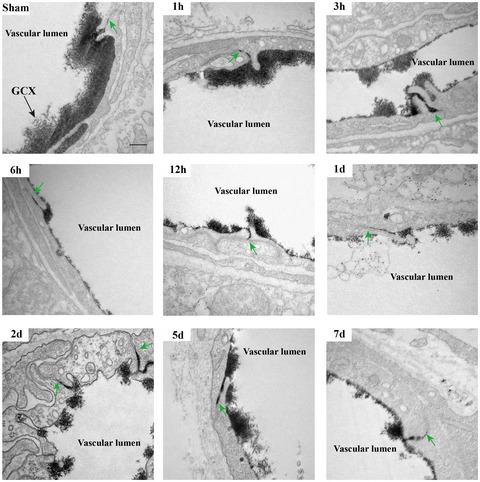当前位置:
X-MOL 学术
›
Brain Pathol.
›
论文详情
Our official English website, www.x-mol.net, welcomes your feedback! (Note: you will need to create a separate account there.)
Glycocalyx is critical for blood-brain barrier integrity by suppressing caveolin1-dependent endothelial transcytosis following ischemic stroke
Brain Pathology ( IF 6.4 ) Pub Date : 2021-07-19 , DOI: 10.1111/bpa.13006 Juan Zhu 1 , Zheqi Li 1 , Zhong Ji 1 , Yongming Wu 1 , Yihua He 1 , Kewei Liu 1 , Yuan Chang 1 , Yuqin Peng 1 , Zhenzhou Lin 1 , Shengnan Wang 1 , Dongmei Wang 1 , Kaibin Huang 1 , Suyue Pan 1, 2
Brain Pathology ( IF 6.4 ) Pub Date : 2021-07-19 , DOI: 10.1111/bpa.13006 Juan Zhu 1 , Zheqi Li 1 , Zhong Ji 1 , Yongming Wu 1 , Yihua He 1 , Kewei Liu 1 , Yuan Chang 1 , Yuqin Peng 1 , Zhenzhou Lin 1 , Shengnan Wang 1 , Dongmei Wang 1 , Kaibin Huang 1 , Suyue Pan 1, 2
Affiliation

|
The breakdown of the blood-brain barrier (BBB) is related to the occurrence and deterioration of neurological dysfunction in ischemic stroke, which leads to the extravasation of blood-borne substances, resulting in vasogenic edema and increased mortality. However, a limited understanding of the molecular mechanisms that control the restrictive properties of the BBB hinders the manipulation of the BBB in disease and treatment. Here, we found that the glycocalyx (GCX) is a critical factor in the regulation of brain endothelial barrier integrity. First, endothelial GCX displayed a biphasic change pattern, of which the timescale matched well with the biphasic evolution of BBB permeability to tracers within the first week after t-MCAO. Moreover, GCX destruction with hyaluronidase increased BBB permeability in healthy mice and aggravated BBB leakage in transient middle cerebral artery occlusion (t-MCAO) mice. Surprisingly, ultrastructural observation showed that GCX destruction was accompanied by increased endothelial transcytosis at the ischemic BBB, while the tight junctions remained morphologically and functionally intact. Knockdown of caveolin1 (Cav1) suppressed endothelial transcytosis, leading to reduced BBB permeability, and brain edema. Lastly, a coimmunoprecipitation assay showed that GCX degradation enhanced the interaction between syndecan1 and Src by promoting the binding of phosphorylated syndecan1 to the Src SH2 domain, which led to rapid modulation of cytoskeletal proteins to promote caveolae-mediated endocytosis. Overall, these findings demonstrate that the dynamic degradation and reconstruction of GCX may account for the biphasic changes in BBB permeability in ischemic stroke, and reveal an essential role of GCX in suppressing transcellular transport in brain endothelial cells to maintain BBB integrity. Targeting GCX may provide a novel strategy for managing BBB dysfunction and central nervous system drug delivery.
中文翻译:

糖萼通过抑制缺血性中风后的小窝蛋白1依赖性内皮细胞转胞吞作用对血脑屏障完整性至关重要
血脑屏障(BBB)的破坏与缺血性脑卒中神经功能障碍的发生和恶化有关,导致血源性物质外渗,导致血管源性水肿,死亡率增加。然而,对控制 BBB 限制特性的分子机制的有限理解阻碍了 BBB 在疾病和治疗中的操作。在这里,我们发现糖萼 (GCX) 是调节脑内皮屏障完整性的关键因素。首先,内皮 GCX 显示出双相变化模式,其时间尺度与 t-MCAO 后第一周内 BBB 对示踪剂的渗透性的双相演变非常匹配。而且,透明质酸酶对 GCX 的破坏增加了健康小鼠的 BBB 通透性,并加重了短暂大脑中动脉闭塞 (t-MCAO) 小鼠的 BBB 渗漏。令人惊讶的是,超微结构观察表明,GCX 破坏伴随着缺血性 BBB 处内皮细胞转胞吞作用的增加,而紧密连接在形态和功能上保持完整。敲除小窝蛋白1 (Cav1) 抑制了内皮细胞胞吞作用,导致血脑屏障通透性降低和脑水肿。最后,共免疫沉淀试验表明,GCX 降解通过促进磷酸化 syndecan1 与 Src SH2 结构域的结合,增强了 syndecan1 和 Src 之间的相互作用,从而导致细胞骨架蛋白的快速调节以促进细胞膜腔介导的内吞作用。全面的,这些发现表明,GCX 的动态降解和重建可能是缺血性卒中 BBB 通透性双相变化的原因,并揭示了 GCX 在抑制脑内皮细胞跨细胞转运以维持 BBB 完整性方面的重要作用。靶向 GCX 可能为管理 BBB 功能障碍和中枢神经系统药物输送提供一种新策略。
更新日期:2021-07-19
中文翻译:

糖萼通过抑制缺血性中风后的小窝蛋白1依赖性内皮细胞转胞吞作用对血脑屏障完整性至关重要
血脑屏障(BBB)的破坏与缺血性脑卒中神经功能障碍的发生和恶化有关,导致血源性物质外渗,导致血管源性水肿,死亡率增加。然而,对控制 BBB 限制特性的分子机制的有限理解阻碍了 BBB 在疾病和治疗中的操作。在这里,我们发现糖萼 (GCX) 是调节脑内皮屏障完整性的关键因素。首先,内皮 GCX 显示出双相变化模式,其时间尺度与 t-MCAO 后第一周内 BBB 对示踪剂的渗透性的双相演变非常匹配。而且,透明质酸酶对 GCX 的破坏增加了健康小鼠的 BBB 通透性,并加重了短暂大脑中动脉闭塞 (t-MCAO) 小鼠的 BBB 渗漏。令人惊讶的是,超微结构观察表明,GCX 破坏伴随着缺血性 BBB 处内皮细胞转胞吞作用的增加,而紧密连接在形态和功能上保持完整。敲除小窝蛋白1 (Cav1) 抑制了内皮细胞胞吞作用,导致血脑屏障通透性降低和脑水肿。最后,共免疫沉淀试验表明,GCX 降解通过促进磷酸化 syndecan1 与 Src SH2 结构域的结合,增强了 syndecan1 和 Src 之间的相互作用,从而导致细胞骨架蛋白的快速调节以促进细胞膜腔介导的内吞作用。全面的,这些发现表明,GCX 的动态降解和重建可能是缺血性卒中 BBB 通透性双相变化的原因,并揭示了 GCX 在抑制脑内皮细胞跨细胞转运以维持 BBB 完整性方面的重要作用。靶向 GCX 可能为管理 BBB 功能障碍和中枢神经系统药物输送提供一种新策略。


























 京公网安备 11010802027423号
京公网安备 11010802027423号